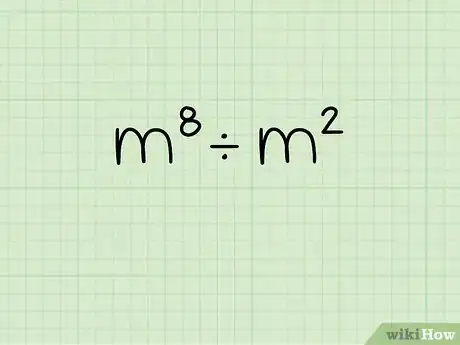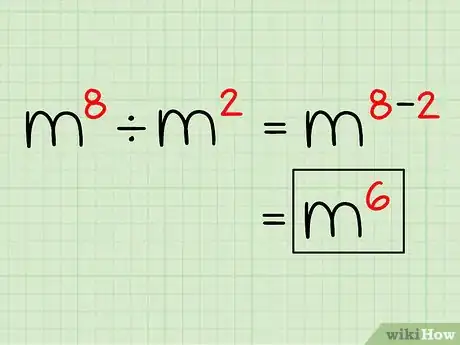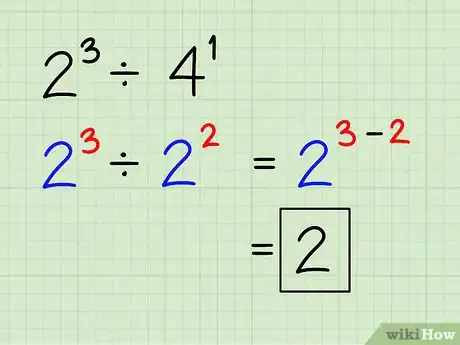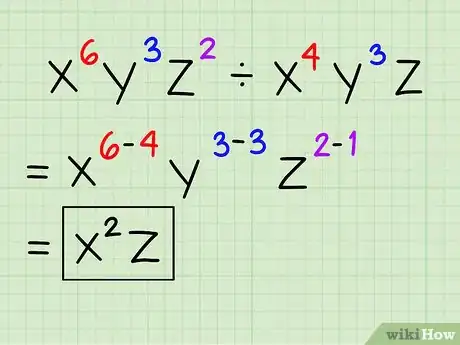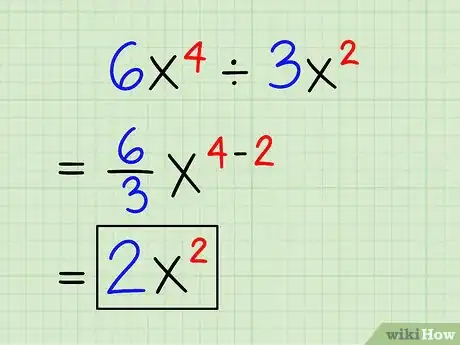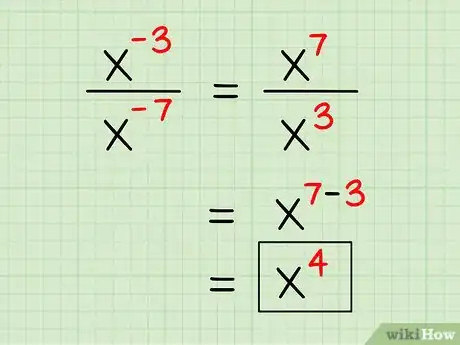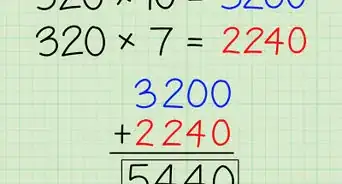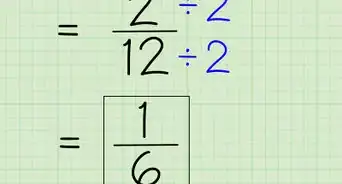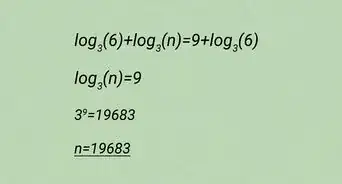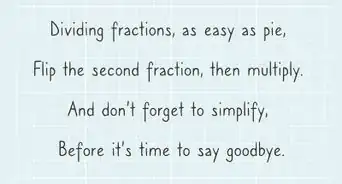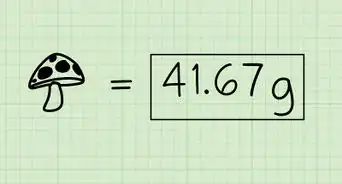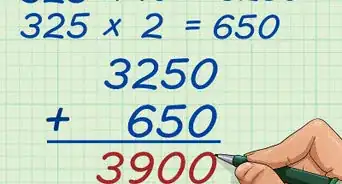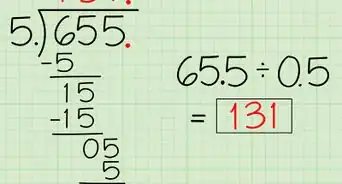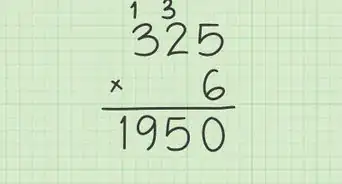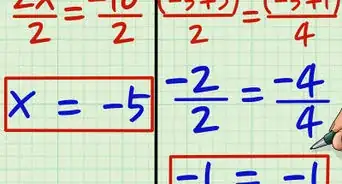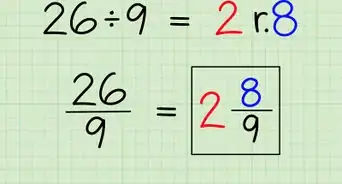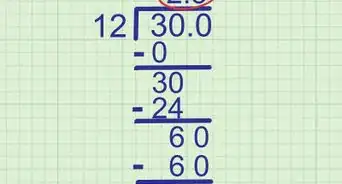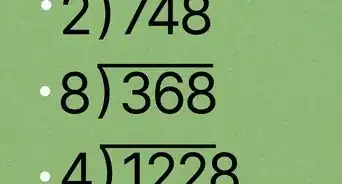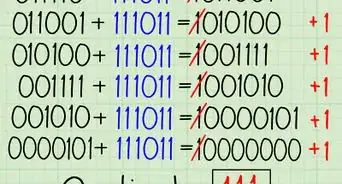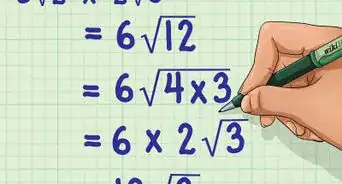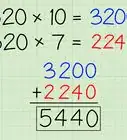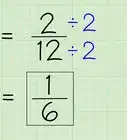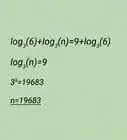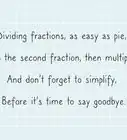This article was co-authored by David Jia. David Jia is an Academic Tutor and the Founder of LA Math Tutoring, a private tutoring company based in Los Angeles, California. With over 10 years of teaching experience, David works with students of all ages and grades in various subjects, as well as college admissions counseling and test preparation for the SAT, ACT, ISEE, and more. After attaining a perfect 800 math score and a 690 English score on the SAT, David was awarded the Dickinson Scholarship from the University of Miami, where he graduated with a Bachelor’s degree in Business Administration. Additionally, David has worked as an instructor for online videos for textbook companies such as Larson Texts, Big Ideas Learning, and Big Ideas Math.
This article has been viewed 160,667 times.
Dividing expressions that have exponents is easier than it looks. As long as you're working with the same base, all you have to do is subtract the values of the exponents from each other and keep the base the same. If you're struggling with this, jump down to Step 1 for easy instructions on getting through the process.
Steps
Understanding the Basics
-
1Write down the problem. The most simple version of this problem will be in the form of ma ÷ mb. In this case, you're working with the problem m8 ÷ m2. Write it down.
-
2Subtract the second exponent from the first. The second exponent is 2 and the first is 8. So, you can rewrite the problem as m8-2.[1]Advertisement
-
3State your final answer. Since 8 - 2 = 6, your final answer is m6. It's that simple. If you're not working with a variable and have an actual number in the base, such as 2, then you would have to do the math (26 = 64) to finish solving the problem.[2]
Going the Extra Mile
-
1Make sure that each expression has the same base. If you're working with different bases, then you cannot divide the exponents. Here's what you need to know:
- If you're working with a problem with variables, such as m6 ÷ x4, then there's nothing more you can do to simplify it.
- However, if the bases are numbers and not variables, you may be able to manipulate them so you end up with the same base. For example, in the problem, 23 ÷ 41, you first have to make both bases be "2." All you do is rewrite 4 as 22 and do the math: 23 ÷ 22 = 21, or 2.
- You can only do this, however, if you can turn the larger base into an expression of squared numbers to make it have the same base as the first.
-
2Divide expressions with multiple variables. If you have an expression with multiple variables, then you just have to divide the exponents from each identical base to get your final answer. Here's how you do it:[3]
- x6y3z2 ÷ x4y3z =
- x6-4y3-3z2-1 =
- x2z
-
3Divide expressions with coefficients. As long as you're working with the same base, it's no problem if each expression has a different coefficient. Just divide the exponents as you normally would and divide the first coefficient by the second. Here's how:[4]
- 6x4 ÷ 3x2 =
- 6/3x4-2 =
- 2x2
-
4Divide expressions with negative exponents. To divide expressions with negative exponents, all you have to do is move the base to the other side of the fraction line. So, if you have 3-4 in the numerator of a fraction, you'll have to move it to the denominator. Here are two examples:[5]
-
Example 1:
- x-3/x-7 =
- x7/x3 =
- x7-3 =
- x4
-
Example 2:
- 3x-2y/xy =
- 3y/(x2 * xy) =
- 3y/x3y =
- 3/x3
-
Example 1:
Community Q&A
-
QuestionHow can I divide a by b, if both have exponent c?
 DonaganTop AnswererIt would be the fraction (a/b) raised to the power of c.
DonaganTop AnswererIt would be the fraction (a/b) raised to the power of c. -
QuestionHow do I divide a positive number with a positive exponent by a positive number with a negative exponent?
 Community AnswerFirst of all, the two positive numbers (the bases) have to be the same. If they are, you subtract the exponent in the denominator from the exponent in the numerator. If the denominator's exponent is negative, you treat it as if it were positive and add it to the numerator's exponent. Thus, x^3 ÷ x^(-1) = x^4.
Community AnswerFirst of all, the two positive numbers (the bases) have to be the same. If they are, you subtract the exponent in the denominator from the exponent in the numerator. If the denominator's exponent is negative, you treat it as if it were positive and add it to the numerator's exponent. Thus, x^3 ÷ x^(-1) = x^4. -
QuestionWhat is 400 divided by 10^3?
 Community Answer400 / 10³ = 400 / 1000 = 0.4.
Community Answer400 / 10³ = 400 / 1000 = 0.4.
References
- ↑ http://www.dummies.com/how-to/content/how-to-divide-exponents.html
- ↑ https://www.mathsisfun.com/algebra/variables-exponents-multiply.html
- ↑ http://www.mathsisfun.com/algebra/variables-exponents-multiply.html
- ↑ https://www.khanacademy.org/math/algebra/x2f8bb11595b61c86:rational-exponents-radicals/x2f8bb11595b61c86:exponent-properties-review/v/multiplying-and-dividing-powers-with-integer-exponents
- ↑ http://www.purplemath.com/modules/simpexpo2.htm
About This Article
To divide exponents with the same base, start by subtracting the second exponent from the first. For example, if your problem is m to the 4th power divided by m to the 2nd power, then you would subtract 2 from 4 in order to get 2. That means your final answer is m to the 2nd power. Alternatively, if your problem is 2 to the 5th power divided by 2 to the 2nd power, subtract 2 from 5 to get an answer of 2 to the 3rd power. To learn how to divide expressions with coefficients, keep reading!
